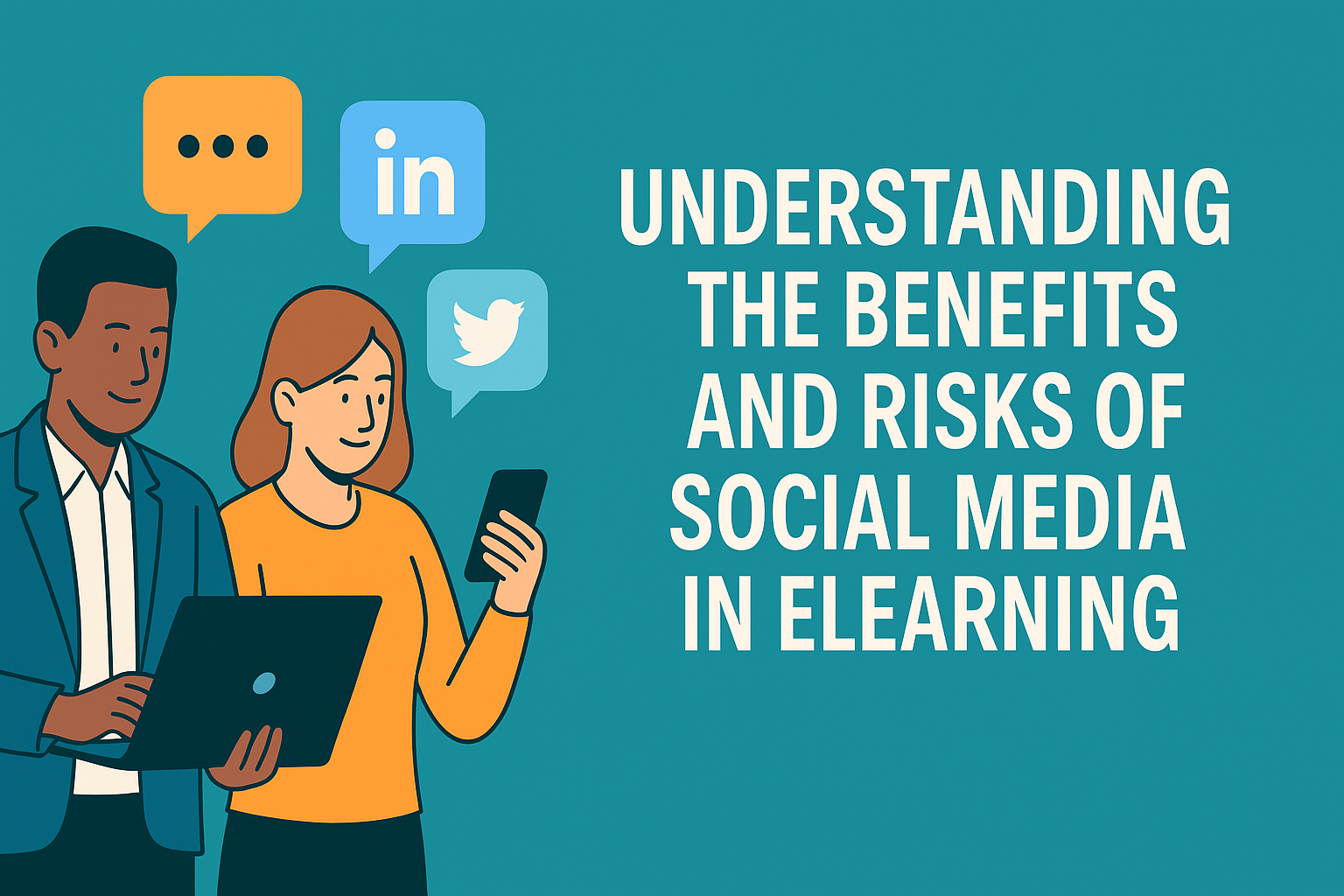Online learning
Online learning
[ follow ]
#elearning #instructional-design #personalized-learning #lms #corporate-training #learning-and-development
fromeLearning Industry
12 hours agoTwo Years At The Top: SweetRush Is eLearning Industry's No. 1 Provider
eLearning Industry curates this list to recognize top-tier content providers who create compelling strategies to boost employee morale and productivity, foster creative thinking, and build motivation and commitment over the long term. Christopher Pappas, eLearning Industry Founder, credits SweetRush's learner-centric approach with its ability to craft transformative learning experiences that "spark curiosity, drive growth, and empower [its client-partners'] workforce." Purpose and autonomy are key components of a successful employee engagement training program.
Online learning
Online learning
fromeLearning Industry
6 days agoThe ROI Of Learning Transformation: Proving The Business Impact Of eLearning Investments
Data-driven learning transformation links digital eLearning to measurable business outcomes, converting L&D from a cost center into a demonstrable driver of productivity and growth.
fromeLearning Industry
6 days agoHow Smarter Scheduling Elevates Learning Efficiency For Training Providers
L&D programs are becoming more complex. Many learning and Instructional Designers manage hybrid, remote, and in-person training sessions all at once. Sending reminders, handling cancellations, and coordinating schedules can quickly become overwhelming. Inefficient scheduling in training programs doesn't just waste time; it also undermines the effectiveness of the program. It can lead to missed sessions, instructor conflicts, and underutilized resources. These issues affect both learners and the success of your programs.
Online learning
Online learning
fromeLearning Industry
1 week agoChoosing The Right Learning Strategy: A Practical Guide For L&D Leaders In Highly Regulated Industries [eBook Launch]
Choose L&D strategies tailored to learner profiles, delivery context, and regulatory requirements to deliver scalable, engaging, measurable, and audit-ready training aligned to business goals.
fromeLearning
1 week agoThe Rising Influence of Artificial Intelligence (AI) and Machine Learning (ML) in eLearning - eLearning
Artificial Intelligence (AI) is basically teaching computers to think and make decisions like humans do. Imagine having a super-smart assistant who never gets tired, never forgets anything you've told them, and can process massive amounts of information in seconds. That's AI in a nutshell. In the world of online learning, these technologies work together to create something we've never had before: educational experiences that actually adapt to each person's unique needs and learning style.
Online learning
fromeLearning Industry
1 week agoThe Power Of Voice: Elevating eLearning Through Voice-Over
Voice-over adds a human dimension to digital learning. It guides learners through content, clarifies complex ideas, and creates a sense of presence that static text and visuals alone cannot achieve. In asynchronous environments-where learners navigate content independently-it serves as a virtual instructor, offering structure, tone, and emphasis that help learners stay focused and emotionally connected. Enhancing Engagement And Attention One of the most powerful benefits of voice-over is its ability to anchor learner attention.
Online learning
fromWIRED
1 week agoThe AWS Outage Was a Nightmare for College Students
When Abby Fagerlin tried logging into Canvas, a popular educational technology platform, to check on her assignments Monday morning, she couldn't get in. That meant the 19-year-old college sophomore, who is studying physics at Pasadena City College, was unable to access materials she needed for her three classes, which were hosted on or linked through the learning management system. After searching online, she realized the Amazon Web Services outage that crippled much of the internet Monday had also temporarily taken down Canvas.
Online learning
fromeLearning Industry
1 week agoA Human-Centered Framework For AI In L&D, Part 2: Programmatic Enablement
To avoid a chaotic, ad hoc and, above all, risky AI implementation, all of your people need to be onboarded to your AI strategy and vetted collection of AI tools. It's also great for your people: Research shows that folks who understand AI are more likely to engage with AI tools and less likely to view AI with fear or mistrust. And given the 82% of leaders planning to expand the capacity of their workforce with digital labor, there's no time like the present.
Online learning
fromeLearning Industry
1 week agoHow To Create Effective Training Videos: A Step-By-Step Guide
With generative AI, robotics, automation, and other technologies transforming how people do their jobs, corporate training has become more crucial. That said, company leaders shouldn't conduct any old form of training just to check it off the list. Evolving technologies mean corporate training must evolve, too. And that's why leaders should invest in video-based training by creating high-quality training videos that teach employees the skills, concepts, and workflows they need to thrive in the future workforce.
Online learning
Online learning
fromZDNET
2 weeks agoThis free Google AI course could transform how you research and write - but act fast
Free four-week Google course trains journalists and communicators on Gemini, NotebookLM, Pinpoint, and Google AI tools for research, writing, workflow, content creation, and audience engagement.
Online learning
fromBusiness Insider
2 weeks agoI earned my master's from Full Sail University. I thought the online program would be easy, but then I got pregnant.
A fully online master's provided necessary flexibility but demanded proactive community-building and rigorous time-management, especially while navigating pregnancy and parenting responsibilities.
Online learning
fromSocial Media Explorer
2 weeks agoHow to Use Social Media to Improve Your Financial Planning - Social Media Explorer
Use social media as an entry point for financial education; curate for reputable, educational content, avoid envy triggers, and consult a professional for personalized planning.
fromeLearning Industry
2 weeks agoCreating eLearning Together: How Geographically Distributed Teams Can Collaborate Effectively
The reality for many, however, is often far more chaotic. Teams are often spread across cities, time zones, and even continents. Version control becomes nightmarish, and valuable feedback can easily get lost in endless email chains. In such a distributed environment, working on a complex project like an eLearning course requires a centralized, collaborative hub. That's where collaboration tools for online learning come in.
Online learning
fromeLearning Industry
2 weeks agoThe Hidden Costs Of Developing Multilingual eLearning Courses With Separate SCORM Files
It sounds easy: translate text, swap media, export new SCORM and upload to the LMS. But for learning developers, this strategy can insidiously double workload, balloon expenses, and add complexity to maintenance when developing multilingual eLearning courses. Let us find out how this affects the eLearning development process and how Instructional Designers and developers can build more scalable multilingual solutions.
Online learning
fromSlate Magazine
2 weeks agoThe Word Vaccine Is Derived From the Latin Word for Which Animal?
You wanted more quizzes, and we've delivered! Now you can test your wits every day of the week. Each weekday, your host, Ray Hamel, concocts a challenging set of unique questions on a specific topic. At the end of the quiz, you'll be able to compare your score with that of the average contestant, and Slate Plus members can see how they stack up on our leaderboard. Share your score with friends and compete to see who's the brainiest.
Online learning
fromForbes
3 weeks ago17 Free Google Career Certificates For $100,000+ Jobs In 2026
These courses enable you to learn specific high-income skills that are in strong demand in the job market and business world, such as: Digital marketing (digital marketing manager's average salary is $115,281) Web development (senior web developer's average salary is $117,821) App development (mobile app developer's average salary is $105,982) Google Analytics (product analyst's average salary is $106,532) Gen AI (Gen AI skills boost the salary potential of any role by up to 47%)
Online learning
Online learning
fromeLearning Industry
3 weeks agoManaged Learning Services: Building The Future Of Learning Ecosystems
Partnering with a Managed Learning Services provider enables organizations to build agile, scalable, and connected L&D ecosystems that reduce vendor complexity, costs, and administrative burden.
fromeLearning Industry
3 weeks agoGlobal Learning Gap: Can eLearning Help Bridge It?
While some learners attend top schools with endless resources, others face barriers such as poor infrastructure, unreliable electricity, no internet access, or the inability to afford even basic educational tools. The pandemic highlighted this divide even further because online learning became popular quickly, but those without devices or connectivity were left behind. At the same time, though, there's hope that eLearning can solve the global learning gap.
Online learning
fromeLearning Industry
3 weeks agoDriving AI Adoption In L&D: What CEOs Need To Know Now
AI adoption is no longer optional in corporate learning; it is an investor and buyer expectation. For investors, Artificial Intelligence is a signal of scalability and long-term growth in a very fluctuating environment. On the other hand, for buyers, AI adoption is a sign of a modern, future-proof platform. Specifically, in the L&D industry, learners witness the potential of Machine Learning via personalization, adaptive AI workflows, and measurable results.
Online learning
fromIT Pro
3 weeks agoIT and business pros call for more tech training
With the tech skills gap showing no signs of closing, very few IT and business professionals believe they're getting enough support for tech learning. A survey of 1,500 tech executives, IT professionals, and business professionals in the US, UK, and India from tech workforce development firm Pluralsight has revealed that while 95% say building a culture of learning is a priority at their organization, the same number believe they need more support to learn tech skills.
Online learning
Online learning
fromeLearning Industry
3 weeks agoSweetRush And Cornerstone Sign Service Partner Agreement, Amplify Impact
SweetRush signed a service partner agreement with Cornerstone to jointly deliver AI-powered, skills-first learning, LMS integration, and talent solutions that address L&D and skill gaps.
fromeLearning Industry
3 weeks agoeLearning Industry's Guest Author Article Showcase [September 2025]
Diving Into The Latest eLearning Trends And L&D Pro Insights From providing more meaningful feedback that drives employee engagement to mastering AI prompting techniques for instructional storytelling, September's publication calendar was packed with standout guest author submissions. So, we've chosen a few to feature in this roundup. In no particular order, here are last month's top guest author articles. 5 Guest Author Articles To Check Out Today
Online learning
fromeLearning Industry
3 weeks agoHow To Fast-Track Your Way Into High-Paying Tech Careers With Online Degrees
For many, the traditional path of a four-year, on-campus degree followed by entry-level roles seems dauntingly long and expensive. However, a seismic shift in education, accelerated by digital advancements, has opened up a highly effective, fast-tracked alternative: online degrees. These aren't just stop-gap solutions; they are increasingly recognized and respected pathways for ambitious individuals to pivot into, or accelerate within, the high-demand tech landscape.
Online learning
fromeLearning Industry
3 weeks agoHow Employee Training Software Improves Team Performance?
Prolonged skills gaps impair productivity. With rapid rates of change in the workplace, the needed skillsets have changed by approximately 25% since 2015 and are set to change by 50% in 2027. Economists caution that more efficient matching of worker skills to job requirements would help to increase productivity and reduce unemployment by a significant margin. Training software is used to fill these gaps by proactively creating and training competencies, thereby avoiding the time, errors, and turnover that result when competency gaps are not addressed.
Online learning
fromeLearning Industry
4 weeks agoeLI Proudly Presents: Exploring L&D Professional Development And The Performance Academy With David James
Many L&D practitioners must balance handling today's training needs with long-term business objectives that have a demonstrable impact on ROI. So, which skills should Learning and Development pros acquire to keep up with emerging tech and truly impact employee performance? Meet Our Guest David has over 20 years of experience in people development and is the former Director of Learning, Talent, and Organizational Development at The Walt Disney Company EMEA.
Online learning
fromDiscover the Best Podcasts | Discover Pods
1 month agoPodcasts on Leadership: Be a Better Leader
People hunt for shortcuts - some podcast episode that dials in confidence and charisma overnight. Spoiler: not happening. What actually works are the small, compounding habits any of us can pick up if we pause long enough to listen and apply. I've made rent hustling side projects, missed on others, and learned the same lesson every time: leadership doesn't come as inspiration; it comes as repetition.
Online learning
fromenglish.elpais.com
1 month agoAndres ta Chikinib, the teacher who taught ChatGPT Tzotzil: It already speaks like a child of three or four'
When Jose Andres Hernandez Perez began teaching Tzotzil to non-speakers a year ago, he didn't consider what he eventually ended up doing: teaching a non-human student. The idea of instructing ChatGPT came from one of his students, who suggested that he use it as a platform to help him generate teaching materials. The results of his first class were a disappointment, but he admits his fault for having passed on the Tzotzil information without any order.
Online learning
fromeLearning Industry
1 month agoSimple, High-Impact Visual Design Principles Every Instructional Designer Should Know
Text Required For Instructional Design/Development (Internal-Facing Text) Learning objectives Scope and sequence Blueprints for stakeholder sign-off Instructor guides Storyboards and scripts (for multimedia production) Text Required For Instructional Delivery (Learner-Facing Text) Course packaging (e.g., LMS home page) Schedule/syllabus Subject-oriented content (such as assigned textbooks or articles) Activity/assessment instructions User Interface writing for all ungraded practice interactivities Assessments and rubrics Video transcripts, closed captions, and callouts Image titles, captions, and callouts
Online learning
fromeLearning Industry
1 month agoGamified Learning For Higher Education Publishers: Drive Retention And Publisher ROI
There's a growing sense of disconnect between the content you create and the outcomes institutions expect. The biggest pain point? Student retention. The numbers tell a stark story: only about 64% of first-time, full-time students who begin at four-year public institutions complete a bachelor's degree within six years [1]. That means a third of students leave before completion-taking with them not just tuition dollars, but your opportunity for renewal, repeat use, and long-term loyalty.
Online learning
fromeLearning Industry
1 month agoLearning Evolved: 25 Years Of Insights For Modern L&D [eBook Launch]
How Can L&D Teams Use This Workbook? Tools, technologies, and methodologies are evolving faster than ever in the L&D sphere. However, many organizations are lagging behind. Here's how this eBook can help you create more impactful training initiatives: Benchmark where your organization stands in the eLearning journey. Spot what's working and what's failing in today's L&D landscape. Learn from real Fortune 500 case studies-what they got right, and where they tripped. Build an action plan to move up the maturity ladder.
Online learning
Online learning
fromeLearning Industry
1 month agoHow Learning And Development Can Support Employees During Career Transitions
L&D should deliver timely, personalized upskilling and emotional support to enable smooth career transitions, retain talent, and preserve institutional knowledge amid rapid workplace change.
fromSocial Media Today
1 month agoLinkedIn Launches Career Hub to Help Maximize Career Opportunities
Trending Skills insights will help organizations understand the skills that their employees have, so they can identify gaps, and track emerging trends across industries. "It combines internal data from employee LinkedIn profiles with external benchmarks to support smarter learning and talent decisions." help connect employees with internal career opportunities. LinkedIn will highlight the skills needed for these roles and suggests relevant courses users can take to enhance their skills.
Online learning
[ Load more ]






















